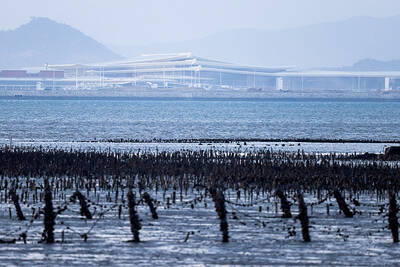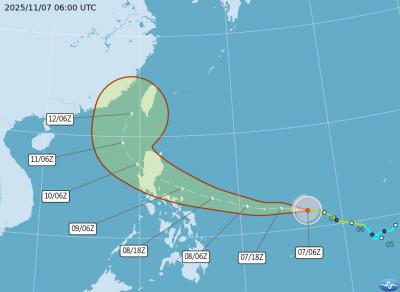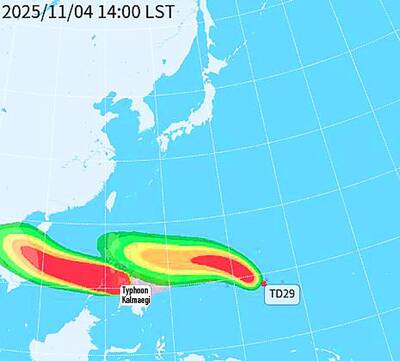Typhoon Morakot could have changed the fate of the Alishan Forest Railway, one of the world’s few alpine railways, once and for all.
Built as a logging workhorse by the Japanese and later turned into a tourist attraction, the railway is now facing a crisis after the typhoon undermined the tracks with the worst flooding in Taiwan in half a century.
Torrential downpours that fell non-stop for nearly three days brought the mountain railway to a complete halt, with its tracks damaged or washed away by flash floods in more than 400 places.
Tourists attracted to Alishan (阿里山) by the thrill of taking a pre-dawn train ride to watch the sun rise from a cloud sea over Taiwan’s highest peak Yushan (玉山) as the whistle of the mountain trains in the distance piercing the calm, will be out of luck now, as the Forestry Bureau, which oversees the railway, has no timetable for when or even if the railway will run again.
Hung Ju-chiang (洪如江) of National Taiwan University, an expert in geotechnical engineering, said many sections of the 86km narrow gauge network built a century ago are constructed on soft, loose colluvial soil, making them vulnerable to floodwater and landslides.
“These vulnerable sections have been financial black holes because of their liability to fail,” said Hung, a member of the government’s Post-Typhoon Morakot Reconstruction Committee.
He said that several sections of the railway are worthy of conserving because of their high tourism value, but said other vulnerable sections should be abandoned altogether.
Instead, he suggested, a cable car system could be built over the Alishan scenic area, which is one of the top three “must sees” for Chinese tourists.
Before the killer typhoon, which claimed the lives of more than 600 people, government agencies had listed the railway as a potential candidate for inclusion as a UN World Heritage Site.
The railway is unique, with several steep gradients, a spiral and four switchbacks. It climbs through the most dramatic climate changes of any railway of its kind in the world, running from an elevation of 30m in Chiayi City to the terminal station of Alishan, located near the Yushan massif that is part of the nation’s Central Mountain Range at 2,274m.
The vegetation along the way changes from tropical to temperate and finally alpine.
The line’s unique Z-shaped switchbacks and spirals are a marvel of engineering and the huge US-built iron Shay locomotives that began bringing down timber in 1912 were something Taiwanese had never seen before.
According to Alishan Forest Railway, a historical account of the railway authored by the late Chang Hsin-yu (張新裕) — who worked for 50 years on the railway, initially called the Imperial Taiwan Railway and retired as its head administrator — the Alishan Forest Railway also serves as a window on Taiwan’s Japanese colonial history.
The Japanese colonial government began planning the narrow gauge line in the late 19th century as a means to facilitate the logging of the area’s valuable red cypress.
A Japanese official in charge of development in Taiwan, Ohtosaku Saito, ventured into the Central Mountain Range in 1896, the year after the Japanese occupation, as the head of a 27-member expedition.
Their aim was to find Yushan, but on the way, they accidentally discovered a huge coniferous forest on Alishan, Chang’s book says.
In his report to then-Taiwanese governor-general Maresuke Nogi, Saito wrote that he had found a great number of giant ancient trees, many of which were more than 1,000 years old.
The Japanese then commenced a systematic exploitation of these rich timber reserves, beginning with building the railway and ordering rolling stock from the US.
Trains trundling huge tree trunks down the mountain became a daily sight. The logging and transport — with 60 trains running daily, each carrying 10 tonnes of lumber — continued until 1945 when Japan was defeated and surrendered Taiwan.
During those decades, the Japanese carried away immeasurable amounts of wood, particularly Formosan red cypress and yellow cypress, known in Japanese as hinoki.
Initially, the railway — passing through 50 tunnels and over 77 wooden bridges — was used only for transporting lumber and forestry workers. Passenger carriages were not added until 1918.
During the railway’s construction, one of the engineers found that a mountain, Datashan (大塔山), was blocking the railway’s progress. After finding that both tunneling and constructing spirals were impossible, he invented the unprecedented Z-shaped switches, allowing the locomotives to climb the mountain traveling forward and the backward on each leg of the “Z.”
Four of these switchbacks took the railway from an elevation of 1,827m to 2,274m.
According to Lin Chin-kun (林金坤), chairman of the Alishan Railway Cultural Foundation (阿里山鐵道文化協會), the steam locomotives needed to be changed three times during the ascent, from 18-tonne locomotives to the heavier and higher horsepower 28-tonne engines.
The trains also needed to stop for water four times on the journey from Fencihu (奮起湖) to the top of Alishan, and the “water cranes” used to replenish the boilers can still be seen today at some of the stations along the track.
Around 20 of the locomotives were in operation, traveling at a speed of 12kph on the seven-hour trip up the mountain.
In 1963, according to Lin, the Forestry Bureau replaced most of the steam locomotives with diesel engines, enabling passenger trains to make the trip in two hours and 50 minutes.
Natural adversaries like floodwater, landslides and earthquakes are not the only factors that have led to the uncertain future of the railway.
The opening of the Alishan Highway in 1982 took away a large number of rail passengers, who took advantage of the cheaper tickets and shorter travel time offered by buses and the railway was eventually privatized under the build-operate-transfer model last June.
Business has since picked up steam as a result of the opening to Chinese tourists, but reactions to the private company’s operation of the railway and the services it offers have been mixed.
One bone of contention is that passengers must disembark at one point and climb about 500m because a 70m section has not been repaired since its base was washed away by floodwater triggered by two typhoons in September last year.
Since the further devastation wrought by Typhoon Morakot, the private operator has estimated that it will cost at least NT$1.1 billion (US$33.54 million) to fix the damage before trains can run again, not taking into account the time factor.
Transport problems notwithstanding, however, the draw of Alishan’s famous Trail of Divine Trees, the sunrise over Yushan and more than 5,000 flowering cherry trees, many of which date back to 1903, is still as strong as ever.

UNILATERAL MOVES: Officials have raised concerns that Beijing could try to exert economic control over Kinmen in a key development plan next year The Civil Aviation Administration (CAA) yesterday said that China has so far failed to provide any information about a new airport expected to open next year that is less than 10km from a Taiwanese airport, raising flight safety concerns. Xiamen Xiangan International Airport is only about 3km at its closest point from the islands in Kinmen County — the scene of on-off fighting during the Cold War — and construction work can be seen and heard clearly from the Taiwan side. In a written statement sent to Reuters, the CAA said that airports close to each other need detailed advanced

Tropical Storm Fung-Wong would likely strengthen into a typhoon later today as it continues moving westward across the Pacific before heading in Taiwan’s direction next week, the Central Weather Administration (CWA) said. As of 8am, Fung-Wong was about 2,190km east-southeast of Cape Oluanpi (鵝鑾鼻), Taiwan’s southernmost point, moving westward at 25kph and possibly accelerating to 31kph, CWA data showed. The tropical storm is currently over waters east of the Philippines and still far from Taiwan, CWA forecaster Tseng Chao-cheng (曾昭誠) said, adding that it could likely strengthen into a typhoon later in the day. It is forecast to reach the South China Sea

Almost a quarter of volunteer soldiers who signed up from 2021 to last year have sought early discharge, the Legislative Yuan’s Budget Center said in a report. The report said that 12,884 of 52,674 people who volunteered in the period had sought an early exit from the military, returning NT$895.96 million (US$28.86 million) to the government. In 2021, there was a 105.34 percent rise in the volunteer recruitment rate, but the number has steadily declined since then, missing recruitment targets, the Chinese-language United Daily News said, citing the report. In 2021, only 521 volunteers dropped out of the military, the report said, citing

WEATHER Typhoon forming: CWA A tropical depression is expected to form into a typhoon as early as today, the Central Weather Administration (CWA) said yesterday, adding that the storm’s path remains uncertain. Before the weekend, it would move toward the Philippines, the agency said. Some time around Monday next week, it might reach a turning point, either veering north toward waters east of Taiwan or continuing westward across the Philippines, the CWA said. Meanwhile, the eye of Typhoon Kalmaegi was 1,310km south-southeast of Oluanpi (鵝鑾鼻), Taiwan’s southernmost point, as of 2am yesterday, it said. The storm is forecast to move through central